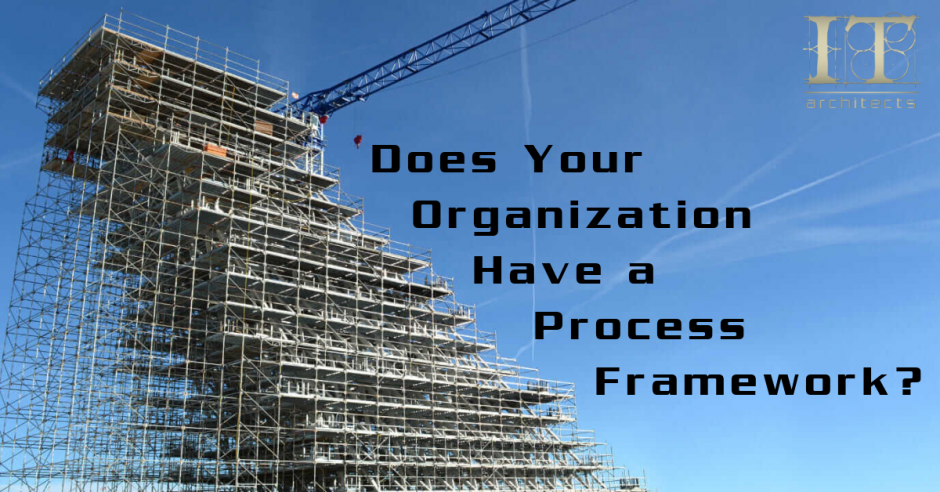Bob Ivkovic, Principal of IT Architects
February 26, 2019
The toughest part of selecting a process framework is understanding what’s available, and which framework to use that will have the most advantage for your organization. A starting point is to ask “How do organizations apply frameworks?” This depends on the type of business process framework being adopted. Organizations use a variation of frameworks, even one that may be customized internally, to develop its business process landscape. Furthermore, how they apply these frameworks determines the success they achieve in formalizing, standardizing, and deploying optimized business processes. Thus, there are three key activities in applying a process framework:
CONDUCT A CURRENT PROCESS ASSESSMENT
A current state process understanding can help you identify the resources your organization needs to go forward. For example, APQC’s Process Classification Framework (PCF) can be used by various industries as a frame of reference for assessing what processes an organization already has, their maturity in terms of consistency and adoption, process standardization across the organization, and if they are well documented for training purposes.
CREATE A PROCESS MAP
A process map can help an organization focus on the most relevant or enabling processes within the organization (i.e. processes that enable other processes and support end-to-end processes chains). The PCF model we identified earlier can be leveraged by organizations in various industries so that they don’t have to start from scratch. This also allows organizations to discover potentially new processes that provide business value or operational efficiencies. Thus, organizations can use existing process frameworks in their mapping efforts as a reference list of processes they can select, prioritize, and chain together across functional areas.
ESTABLISH A COMMON LANGUAGE
Frameworks can be used as a reference model for a taxonomy of work, promoting consistent understanding, and classifying and arranging content. This common language provides a discipline to formalize and standardize business processes within an organization.
I’ve learned that people generally struggle with framework selection and customization. This is probably the reason that they don’t get very far when comes to using a business process framework. Over the last decade, organizations have been challenged on two main fronts:
- Understanding how to adapt a framework to meet organizational needs.
- Aligning performance measures to framework processes.
Just think about that for a second. If you do have a framework in mind, it has to be customized to meet organizational needs. There’s no one-size-fits-all. And if there is no in-house expert to guide the use or customization of a framework to meet organizational needs, chances are you won’t get very far. Furthermore, if there is no way to measure business processes and their improvement margins, there’s really no way to achieve performance targets. I think you’re beginning to understand why many organizations give up on process improvement initiatives, let alone on standardizing their business processes across the enterprise. Thus, organizations don’t have the talent or maturity to adopt the right framework for the organization, or to leverage a framework to build process models or maps.
So, without dwelling on organizational maturity, commitment, and issues, here are 5 tips for adopting the right framework:
- Choose a framework that aligns to your organizational requirements for improving its processes (e.g. Is it industry or functional specific? Does it provide traceability? Does it incorporate metrics or KPIs for process improvement outcomes?)
- Identify activities in the framework that do not align to organizational needs. Ensure that the framework evaluates business processes at the right level of detail for the purpose of modifying, eliminating, or adding processes.
- Establish assessment criteria to determine which relevant processes in an industry reference process framework like PCF need modification. The assessment criteria can ensure the process provides value and supports your organization’s strategic goals.
- Process mapping begins with making a judgement call on where to start and how to determine the relevancy of business processes. Thus, focus on the processes where most time is spent and consider starting at a high level. Keep in mind that process mapping is more an exercise in design than plugging in tools or technologies.
- Distinguish business processes as “enabling” other processes, or as being “enabled”. If a process enables other processes, it is rendered independent and drives the entire end-to-end process chain. If a process is enabled, it is considered to be dependent or just a weaker link in the end-to-end process chain. Thus, an organization should prioritize it’s “enabling” processes and improve those before addressing “enabled” processes.
There has to be a common sense to mapping processes and defining their future transformation, also known as going from a current to future state process map. If the business doesn’t understand the process framework and improving business processes is left to the IT guys, you can be sure that your business processes won’t add business value or provide business benefits. A process framework must be adopted by the business in order to improve its business processes, while IT’s job is to automate those business processes through its applications and interfaces.
Mr. Bob Ivkovic is a Principal with IT Architects in Calgary, Alberta. IT Architects (www.itarchitects.ca) is an information consulting firm specializing in business process optimization, system evolution planning, and the deployment of leading-edge technologies. If you require further information, Bob can be reached at ivkovic@itarchitects.ca or 403-630-1126.


